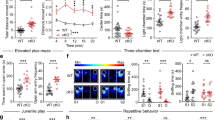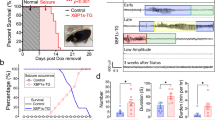Abstract
We found the voltage-gated K+ channel Kv12.2 to be a potent regulator of excitability in hippocampal pyramidal neurons. Genetic deletion and pharmacologic block of Kv12.2 substantially reduced the firing threshold of these neurons. Kv12.2−/− (also known as Kcnh3−/−) mice showed signs of persistent neuronal hyperexcitability including frequent interictal spiking, spontaneous seizures and increased sensitivity to the chemoconvulsant pentylenetetrazol.
This is a preview of subscription content, access via your institution
Access options
Subscribe to this journal
Receive 12 print issues and online access
$209.00 per year
only $17.42 per issue
Buy this article
- Purchase on Springer Link
- Instant access to full article PDF
Prices may be subject to local taxes which are calculated during checkout



Similar content being viewed by others
References
Noebels, J.L. Annu. Rev. Neurosci. 26, 599–625 (2003).
McCormick, D.A. & Contreras, D. Annu. Rev. Physiol. 63, 815–846 (2001).
Peters, H.C., Hu, H., Pongs, O., Storm, J.F. & Isbrandt, D. Nat. Neurosci. 8, 51–60 (2005).
Saganich, M.J., Machado, E. & Rudy, B. J. Neurosci. 21, 4609–4624 (2001).
Becchetti, A. et al. Eur. J. Neurosci. 16, 415–428 (2002).
Trudeau, M.C., Titus, S.A., Branchaw, J.L., Ganetzky, B. & Robertson, G.A. J. Neurosci. 19, 2906–2918 (1999).
Jegla, T.J., Zmasek, C.M., Batalov, S. & Nayak, S.K. Comb. Chem. High Throughput Screen. 12, 2–23 (2009).
Putnam, N.H. et al. Science 317, 86–94 (2007).
Srivastava, M. et al. Nature 454, 955–960 (2008).
Miyake, A. et al. J. Neurosci. 29, 14637–14645 (2009).
Ho, A. et al. J. Neurosci. 26, 13089–13101 (2006).
Holmes, G.L. Neurology 69, S28–S32 (2007).
Nolan, M.F. et al. Cell 115, 551–564 (2003).
Streng, J. Can. J. Psychol. 25, 62–68 (1971).
Kim, J.J. & Fanselow, M.S. Science 256, 675–677 (1992).
Acknowledgements
Lentivirus vectors were kindly provided by A. Maximov. The project was funded by the Genomics Institute of the Novartis Research Foundation, US National Institute of Neurological Disorders and Stroke grants awarded to T.J. and J.N., an American Heart Association fellowship supporting X.Z. and INSERM funds supporting F.B.
Author information
Authors and Affiliations
Contributions
V.L., C.C., C.W., J.A., T.J. and C.S. designed targeting constructs, handled embryonic stem cell work and produced germ-line chimaeras. X.Z. and F.B. established the Kv12.2−/− mouse line, S.M.C. analyzed Kv12.2 expression, and J.W.Y. and J.N. provided EEG analysis. X.Z. and F.B. conducted patch clamp experiments and contributed to manuscript preparation, X.Z., F.B. and K.B. conducted behavioral experiments. T.H., C.D., S.M.C. and T.J. designed the screen for Kv12.2 inhibitors and identified and characterized CX4. T.J. supervised the project, analyzed data and wrote the manuscript.
Corresponding author
Ethics declarations
Competing interests
The authors declare no competing financial interests.
Supplementary information
Supplementary Text and Figures
Supplementary Figures 1–6, Supplementary Methods and Supplementary Sequences (PDF 2367 kb)
Supplementary Video 1
Video and EEG recording of a seizure in an awake, behaving Kv12.2−/− mouse. (MOV 2532 kb)
Supplementary Sequences
Sequences used in phylogenetic analysis in FASTA format. (TXT 15 kb)
Rights and permissions
About this article
Cite this article
Zhang, X., Bertaso, F., Yoo, J. et al. Deletion of the potassium channel Kv12.2 causes hippocampal hyperexcitability and epilepsy. Nat Neurosci 13, 1056–1058 (2010). https://doi.org/10.1038/nn.2610
Received:
Accepted:
Published:
Issue Date:
DOI: https://doi.org/10.1038/nn.2610
This article is cited by
-
Diagnostic yield and novel candidate genes for neurodevelopmental disorders by exome sequencing in an unselected cohort with microcephaly
BMC Genomics (2023)
-
Sex differences in electrophysiological properties and voltage-gated ion channel expression in the paraventricular thalamic nucleus following repeated stress
Biology of Sex Differences (2022)
-
Deficient LEF1 expression is associated with lithium resistance and hyperexcitability in neurons derived from bipolar disorder patients
Molecular Psychiatry (2021)
-
Diversity of voltage-gated potassium channels and cyclic nucleotide-binding domain-containing channels in eukaryotes
Scientific Reports (2020)
-
Deletion of Kv10.2 Causes Abnormal Dendritic Arborization and Epilepsy Susceptibility
Neurochemical Research (2020)



